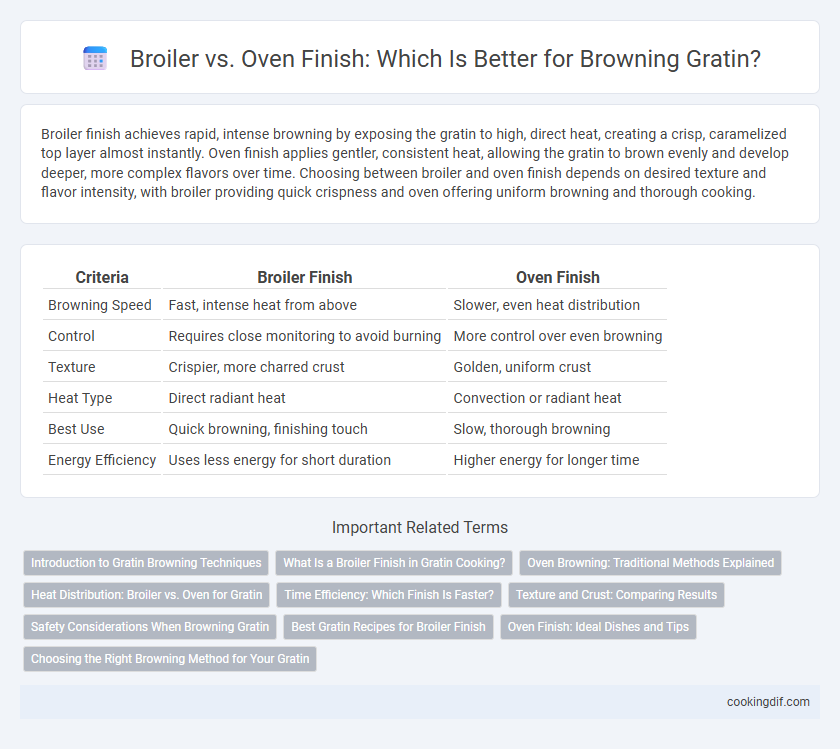Broiler finish achieves rapid, intense browning by exposing the gratin to high, direct heat, creating a crisp, caramelized top layer almost instantly. Oven finish applies gentler, consistent heat, allowing the gratin to brown evenly and develop deeper, more complex flavors over time. Choosing between broiler and oven finish depends on desired texture and flavor intensity, with broiler providing quick crispness and oven offering uniform browning and thorough cooking.
Table of Comparison
| Criteria | Broiler Finish | Oven Finish |
|---|---|---|
| Browning Speed | Fast, intense heat from above | Slower, even heat distribution |
| Control | Requires close monitoring to avoid burning | More control over even browning |
| Texture | Crispier, more charred crust | Golden, uniform crust |
| Heat Type | Direct radiant heat | Convection or radiant heat |
| Best Use | Quick browning, finishing touch | Slow, thorough browning |
| Energy Efficiency | Uses less energy for short duration | Higher energy for longer time |
Introduction to Gratin Browning Techniques
Gratin browning techniques critically influence the final texture and flavor, with broiler and oven finishes offering distinct results. The broiler exposes gratins to intense, direct heat, creating a rapid, crispy crust often ideal for thinner dishes or last-minute finishing. Oven finishing involves dry heat circulating evenly, producing consistent browning and a tender interior, preferred for thicker, layered gratins requiring gradual cooking.
What Is a Broiler Finish in Gratin Cooking?
A broiler finish in gratin cooking uses intense, direct heat from above to quickly brown and crisp the top layer, creating a golden, caramelized crust. This method enhances the texture by producing a contrast between the creamy interior and the crunchy surface. Unlike oven baking, which cooks evenly throughout, broiling targets only the gratin's top, making it an efficient technique for final browning.
Oven Browning: Traditional Methods Explained
Oven browning in gratin dishes relies on radiant heat that evenly caramelizes the top layer, creating a golden crust rich in flavor and texture. Unlike broiler finishing, which provides intense direct heat from above, oven browning uses consistent ambient heat to slowly develop Maillard reactions and melt cheese into a creamy, cohesive topping. This traditional method ensures a tender interior and a perfectly browned, crisp surface without the risk of burning or uneven charring.
Heat Distribution: Broiler vs. Oven for Gratin
Broilers deliver intense, direct heat from above, creating rapid browning and crisping of gratin surfaces, ideal for achieving a golden crust. Ovens provide consistent, even heat surrounding the dish, promoting thorough cooking and uniform browning throughout the gratin. Choosing between broiler and oven finish depends on desired texture: broilers excel in surface caramelization, while ovens ensure balanced heat distribution for overall doneness.
Time Efficiency: Which Finish Is Faster?
Broiler finish achieves browning in as little as 2 to 5 minutes, making it significantly faster than oven finishing, which typically requires 10 to 15 minutes at 400degF (204degC). The broiler's intense direct heat rapidly caramelizes the gratin topping, reducing overall cooking time. This time efficiency makes broiler finishing ideal for quick gratin browning without overcooking the dish.
Texture and Crust: Comparing Results
Broilers deliver intense, direct heat ideal for rapidly browning gratin surfaces, creating a crisp, caramelized crust with slightly airy textures. Ovens provide even, consistent heat that browns gratin more uniformly, promoting a thicker, denser crust and creamy interior texture. Broiler finishes excel in achieving crispiness quickly, while oven finishes enhance depth of flavor and maintain moisture balance within the dish.
Safety Considerations When Browning Gratin
When browning gratin, safety considerations vary between broiler and oven finishes. Broilers expose dishes to intense, direct heat, increasing the risk of burns and fire if left unattended, while ovens provide more controlled, even heat distribution that reduces these hazards. Using heat-resistant gloves and monitoring closely ensures safe handling regardless of the method chosen.
Best Gratin Recipes for Broiler Finish
Broiler finish delivers intense, direct heat ideal for achieving a perfectly browned and crispy gratin top layer, enhancing textures in recipes like classic potato au gratin or cheesy cauliflower gratin. Recipes optimized for broiler finish typically feature evenly layered ingredients with sufficient cheese or breadcrumb topping to ensure a golden crust without overcooking the interior. Compared to oven finishing, broiler finish reduces total cooking time while providing visually appealing caramelization and distinct flavor development in the best gratin dishes.
Oven Finish: Ideal Dishes and Tips
Oven finishing is ideal for gratins that require even, golden-brown crusts, such as potato dauphinoise, vegetable gratins, and macaroni cheese. This method ensures consistent heat distribution, allowing the cheese and breadcrumbs to crisp perfectly without burning. To achieve the best results, place the gratin in the center rack and monitor closely during the last 5-10 minutes, using a broiler briefly if necessary for extra browning.
Choosing the Right Browning Method for Your Gratin
Choosing between a broiler and an oven finish for browning your gratin depends on the desired texture and control level. Broilers provide intense, direct heat ideal for achieving a quick, deeply caramelized crust, while ovens offer steady, even browning suitable for a gradual, uniform finish. Optimal gratin results often involve starting with an oven bake followed by a brief broiler session to balance thorough cooking and perfectly crisp topping.
Broiler vs Oven finish for browning Infographic

 cookingdif.com
cookingdif.com